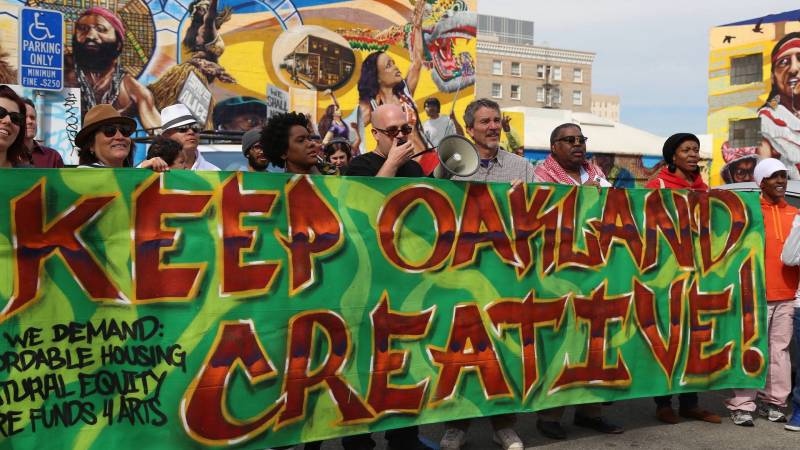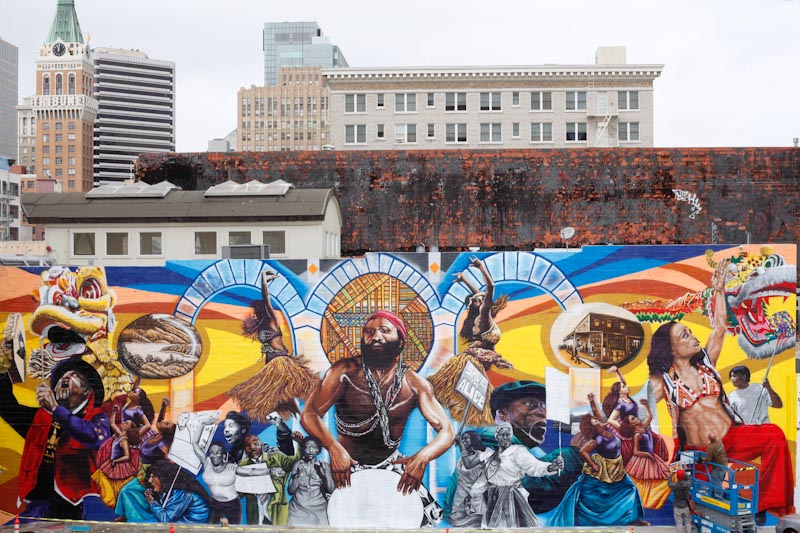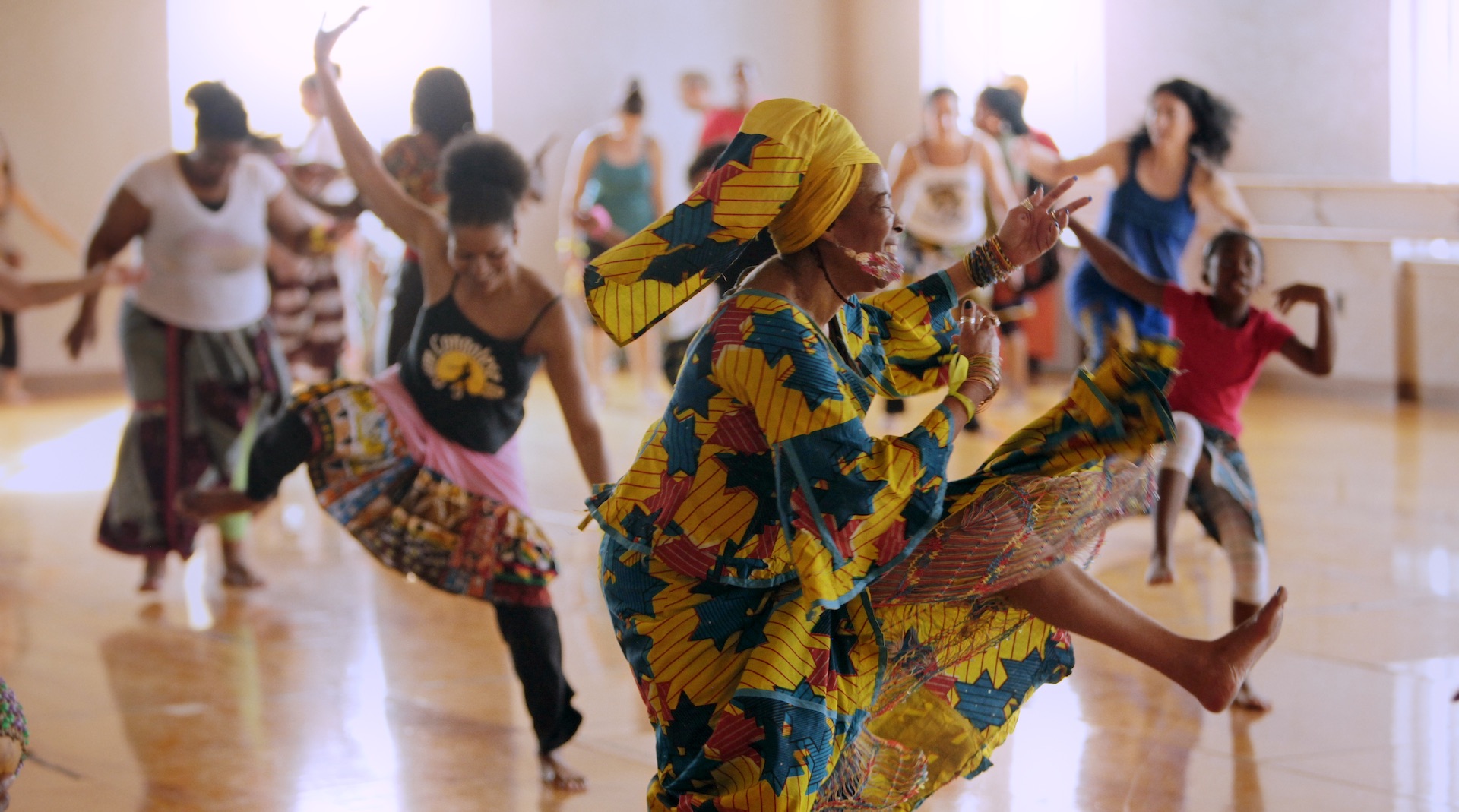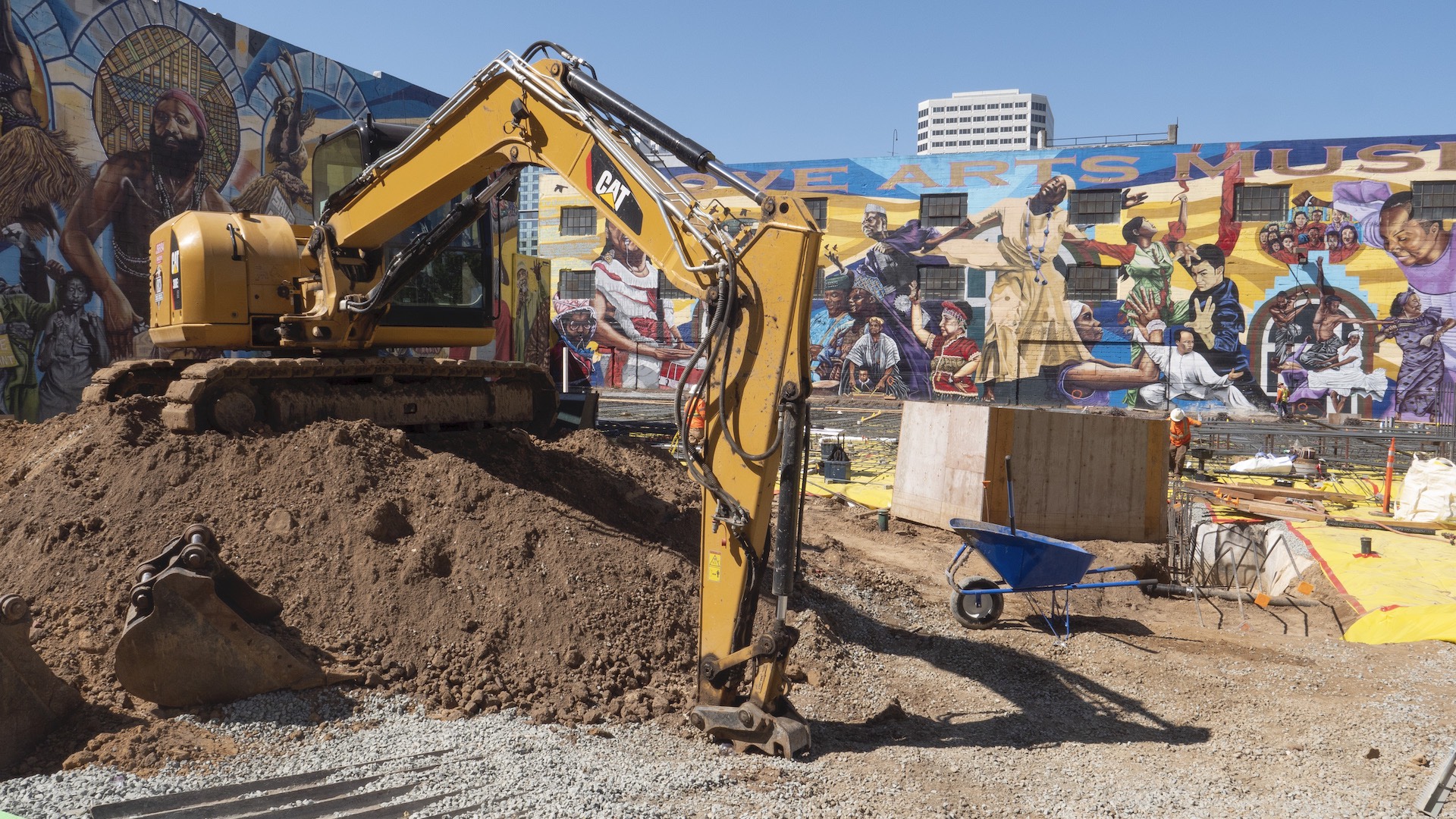Throughout last year, the steel and concrete frame of a new building in downtown Oakland grew to obscure a sprawling mural. Protesters with picket signs disappeared from view, along with dancers, drummers and martial arts practitioners, leaving the faces of centerpieces Malonga Casquelourd and Ruth Beckford, pillars of the city’s black performing arts tradition. To passersby today the entire artwork is imperceptible behind an incoming housing development.
In ‘Alice Street,’ Oakland Artist-Activists Build Power By Bridging Communities

Alice Street, a forthcoming documentary by Spencer Wilkinson, shows how the Universal Language mural’s creation and erasure alike catalyzed a multiracial anti-gentrification coalition with significant, ongoing effects on real estate development and city planning in downtown Oakland. Set in just a few city blocks, it’s a story about intractable loss as well as collective refusal, depicting artists’ role in grassroots activism that builds power by bridging communities.
Wilkinson, 44, an Oakland filmmaker whose first feature, One Voice (2018), focused on the Oakland Interfaith Gospel Choir, did not anticipate filming for five years when he started chronicling the mural’s design as part of a work-trade deal in 2014. Now he’s submitting the 70-minute Alice Street documentary to film festivals and arranging screenings in other cities grappling with gentrification. Wilkinson expects to announce more Bay Area screenings in the coming months.
Alice Street begins with Destiny Muhammad reciting a poem at the corner of 14th and Alice streets in downtown Oakland to subtle, vaguely religious music by Micah Berek. “An intersection of traditions, ancient rhythms, culture keepers and urban oracles,” she says. A montage shows the neighborhood’s cultural diversity and changing built environment. The credits roll, framed by cranes. Imposed on aerial footage of the low-slung flatlands are sharply rising housing costs.
The film shortly settles on aerosol artist Desi Mundo and studio painter Pancho Pescador of the Community Rejuvenation Project embarking on their largest mural yet: Four walls around a parking lot at Alice and 14th streets. For inspiration, they look directly across the street to the Malonga Casquelourd Center for the Arts, a historic city-owned hub of Afro-diasporic drumming and dance, and also to the Chinatown senior apartments and community center Hotel Oakland.
The story has no single conflict or antagonist. The challenge at first appears to be the muralists’ desire to represent two communities to which they’re admitted outsiders, and the project’s most outspoken opponent is an elderly white woman who objects to its exclusion of white people. As soon as the mural is designed and painted to the satisfaction of most neighborhood stakeholders, though, a housing development proposal threatens to render it totally invisible.

“People in the Bay Area are starting to see the benefits of Oakland,” says Maria Poncel of Bay Development, explaining to Mundo and Pescador that the mural will continue to exist behind the planned 16-story tower. “We’re going through sort of a second renaissance.” It’s one of several awkward remarks from developers, property owners and elected officials (has Mayor Libby Schaaf retired “secret sauce”?) that Wilkinson seems to highlight for their evident shallowness.
Halfway through the documentary, then, the mural intended to celebrate cultures at risk of displacement itself confronts disappearance, multiplying its symbolic potency. And the Malonga-Hotel Oakland bloc strengthened through the mural’s development acquires political power that Wilkinson—using interviews and historical flashbacks about racist city planning practices and housing discrimination in Oakland—casts in a longer lineage of racial solidarity.
The goal of the new coalition isn’t immediately evident in the documentary. Theo Williams, leader of Malonga tenant SambaFunk, says at a meeting that he doesn’t necessarily oppose the development, yet no one in the film persuasively argues on its behalf. Complicating the narrative are new problems: Noise complaints resurface concerns about intolerant new neighbors to the Malonga, and the activists crash a city planning process, demanding meaningful representation.

Unsurprisingly for grassroots activism, it’s a dizzying cycle of setback and success. A subplot about Jerry Brown’s early 2000s attempt as Oakland mayor to shutter what was then the Alice Arts Center is a welcome rejoinder to recent hagiography, but it creates some narrative whiplash. Still, the story regains focus when the coalition formally appeals the building’s planning commission approval in order to negotiate a community benefits agreement with the developer.
The coalition secured funds for the Malonga and for a replacement mural (now being designed for the wall of the Greenlining Institute nearby). It also modeled a strategy since used by the coalition to extract concessions from developers worth an estimated $20 million, organizer Eric Arnold says in the film—including 90 affordable homes. With this tactic the same activists recently won a raft of benefits for arts groups in the Kaiser Convention Center redevelopment.
“Resilience” is too often a buzzword that serves to normalize communities’ capacity to withstand abuse, especially from the mouths of powerful people in media and politics. It’s also too flat for the dynamic artist-activists shown in Alice Street, who dance in the streets and navigate city bureaucracy with equal verve. “And then we marched over to the planning office,” recalls Arnold of one decisive action. “It was probably the first time they’ve heard music inside of that office.”

Inevitably some of the story lines in Alice Street go unresolved. The cultural stabilization strategies in the Downtown Oakland Specific Plan published last year derive partly from activism shown in the film, but supporters are disappointed with what little officials have done to enact them. Likewise, tenants of the city-owned Malonga continue to feel chronically neglected, with Williams of SambaFunk recently telling KQED its problems haven’t changed since 1998.
Still, the documentary also captures a heartening generational shift. Standout interviewees Beckford and Michael Lange, the actor and director, died before the film’s completion, but Alice Street shows their commitment to Oakland’s cultural life enduring in Lailan Sandra Huen, Anyka Barber, Casquelourd’s son Kiazi Malonga and others. Wilkinson, meanwhile, is developing educational curriculum to promote the community benefits agreement model beyond Oakland.
It probably doesn’t feel like a silver lining to the muralists, but the four walls of Universal Language haven’t been buffed or repainted. The artwork remains. Recently on Broadway, demolition exposed some mid-20th century advertisements on the side of a building, relics of a barely-recognizable city. It suggests the possibility that Universal Language could daylight again in the lifetime of Oakland’s current residents. The question is who among us will be here to see.

